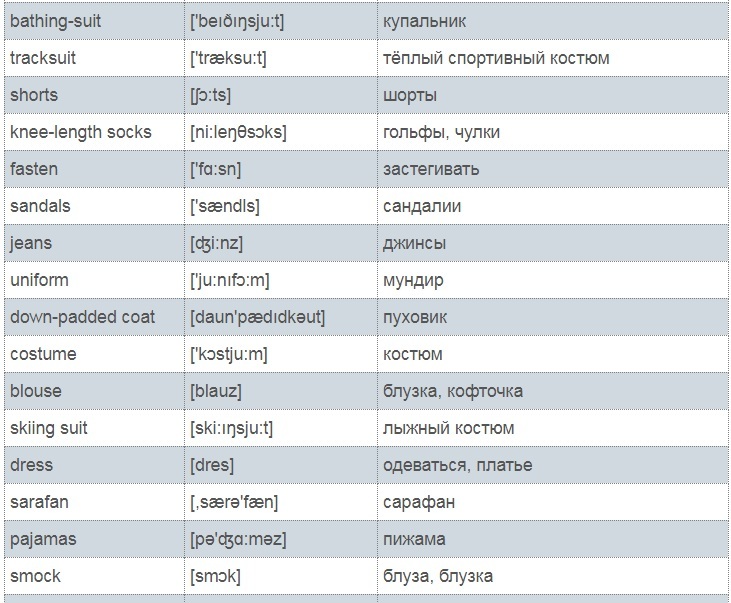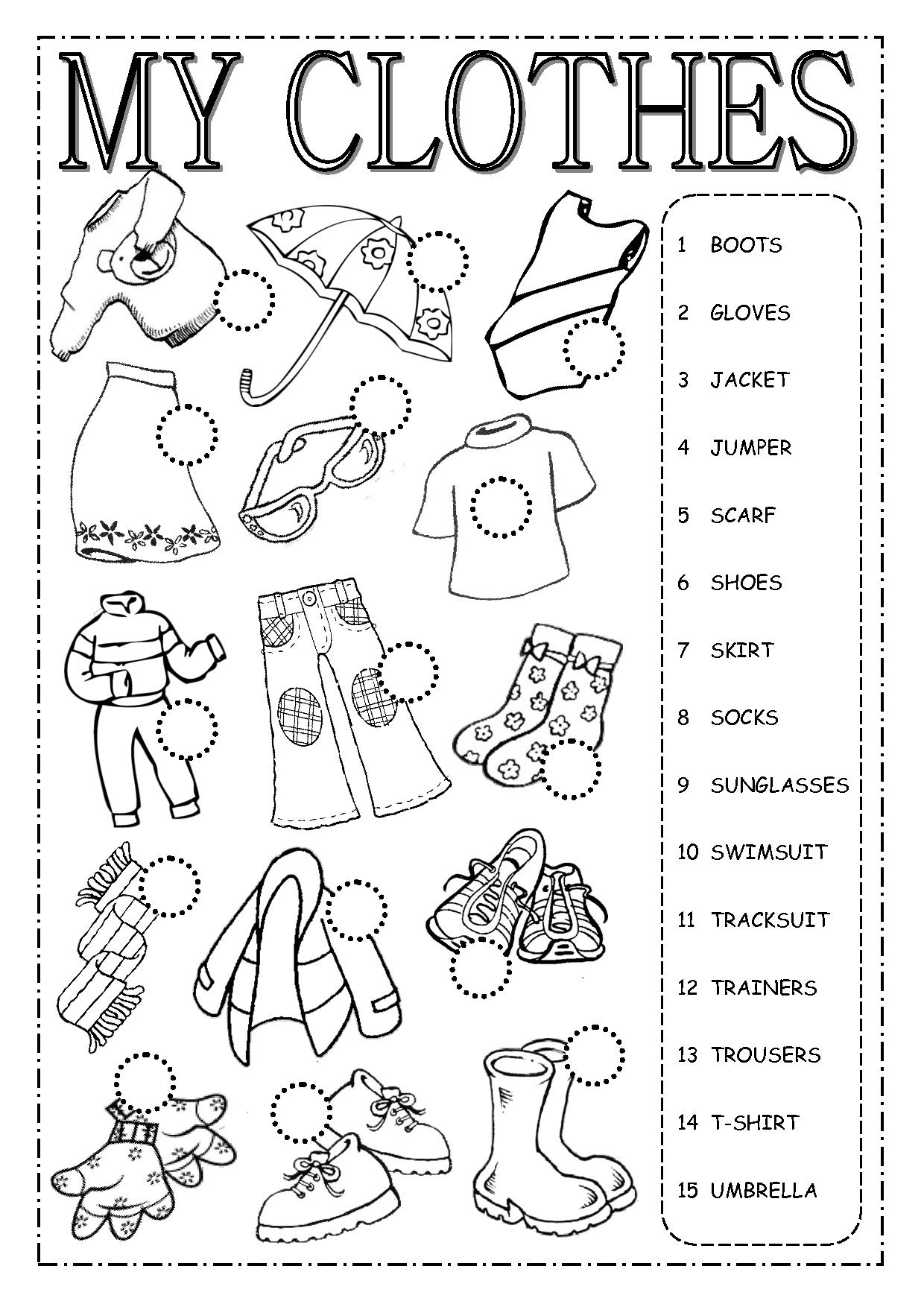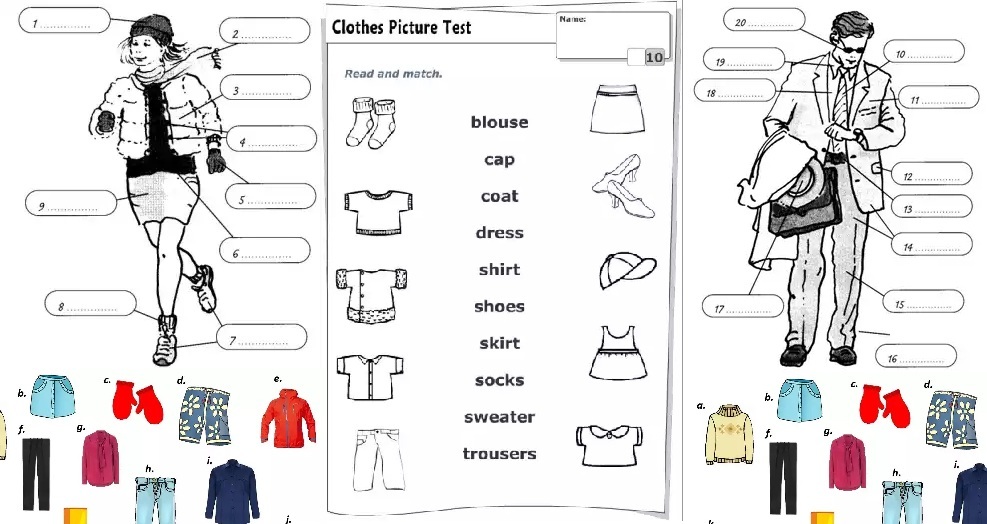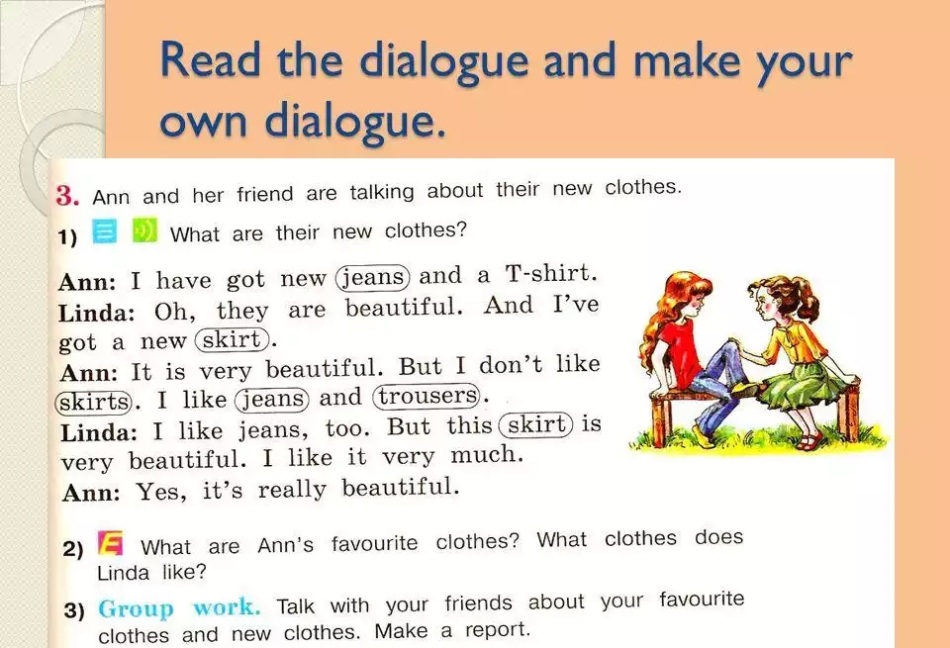In the article you will find tips on organizing and compiling a lesson in English on the topic "Clothing".
Content
- Necessary English words on the topic "Clothing" for beginners, children: a list with transcription and translation
- Exercises in English for children on the topic "Clothing"
- Dialogue in English for children on the topic "Clothing" with translation
- Phrases in English for children on the topic "Clothing" with translation
- Songs for children in English on the topic "Clothing" with translation
- Video: "Teaching song about clothes: English"
- Cards in English on the topic "Clothing" with translation
- Games in English on the topic "Clothing"
- Riddles, tasks and poems in English on the topic "Clothing" with translation
- Cartoons for children on the topic "Clothing"
- Tips for independent study of the topic in English "Clothing" for children and parents
- Video: "Lesson in English: Clothing"
Necessary English words on the topic "Clothing" for beginners, children: a list with transcription and translation
The theme "Clothing" is very important for those who study English. Not knowing the vocabulary of this topic, you cannot describe your appearance, tell the seller in the store what you want or find the right thing at home.
The topic can be divided into a few submissions:
- Outerwear
- clothing
- Shoes
- Accessories
Vocabular of the topic should be written in a dictionary, then practice the correct pronunciation of each word and only then make sentences and dialogs with them. The number of words depends on how adult child (to young children choose the main words for study).
Important: in order to use the words “clothing” in the speech, you should first possess the vocabulary of the “color” section in order to be able to describe the clothes: Red Socks, Blue Jeans, Black Hat.
Vocabular:










Exercises in English for children on the topic "Clothing"
The topic "Clothing" is very large, since there are a lot of wardrobe items and each has its own name. It is not enough just to voice and write down new words, it is necessary to fix the knowledge gained using written and oral exercises.
Exercise options:
- Task number 1: In the task, you should distribute the names of clothing and their images.
- Task number 2: It is necessary to fill in the crossword puzzle with words that correspond to the names of clothing.
- Task number 3: Additional words and sentences with missing letters (vocabulary "Clothing").
- Task number 4: Complete a number of tasks, the main thing is to write the names of the wardrobe items.




Dialogue in English for children on the topic "Clothing" with translation
The best way to consolidate new vocabulary is to actively use it in the compilation and practice of oral dialogs. It is very useful to come up with “realistic” dialogs when you represent a “living” situation and conduct a first -person conversation.
What dialogs can be used:
- Dialogue No. 1 (task):First read the dialogue, and then, according to this example, make your own dialogue. Using vocabulary (tell us about what clothes you like best).
- Dialogue No. 2 (task):Read the dialogs and complement them with the missed words (then stage).
- Dialogue No. 3 (task):Read, complement the dialogue, translate it and play it.



Phrases in English for children on the topic "Clothing" with translation
To compile dialogs on the topic, it is not enough to know vocabular, it is also required to own a certain vocabulary that will help you ask questions and answer them.
Lexics on the topic:
| English | Translation |
| Get Dressed | Dress |
| Dress Up | Dress |
| I undressed | I undressed |
| I took off my jeans | I took off my jeans |
| My Dress is so Beautiful! | My dress is so beautiful! |
| I Don’t Like to Wear Tight Cloth | I don't like to wear cramped clothes |
| I’m Wearing a Sweater Now | I'm dressed in a sweater now |
| I Buy Clothing a Shop | I buy clothes in the store |
| A pair of shoes | A couple of boots |
| This t-shirt is to big for me | This T -shirt is too great on me |
| I WOULD Like to Buy Clothes for a Party | I would like to buy clothes for a party |
| I Don’t Like The Cloth You Wear | I don't like the clothes you wear |
| I Don’T Like What You’re Wearing | I don't like what you are dressed in |
| This Dress Will Fit You | This dress will suit you |
| Idon’T Think ABOUT CLOTHES VERY MUCH | I don't think very much about clothes |
| I Don’t Bother ABOUT CLOTES | I don't bother about clothes |
| MEN HAVE To Wear Ties | Men should wear a tie |
| MEN ARE REQUIRED To Wear A TIE | Men are required to wear a tie |
| I Like to be Comfortable in a cloth | I like to feel comfortable in clothes |
| I Like to Feel Comfortable in Clothes | I like to feel comfortable in clothes |
| I am Very Careful (Thrifty) with My Clothes | I am very attentive (leaning) with my clothes |
| Putting on A Dress | Put on a dress |
| Put on | Put on |
| Take Off | Take off |
| Take Off the Dress | Remove the dress |
| Beautiful Dress | Nice dress |
| Expensive Clothing | Expensive clothing |
| Plaid Shirt | Plaid shirt |
| SKINNY TRUSERS | Tight pants |
Songs for children in English on the topic "Clothing" with translation
Thematic songs exist for each topic in learning English. They were deliberately invented in order to identify interest in children studying the language, as well as to make the learning process fun and positive.
Each teacher must prepare in advance for classes, preparing all the visualization, working material and multimedia files. Songs can be just audio tracks, but it is much more interesting to include video songs for children.
Interesting: with audio-songs to teach English more efficiently, since not only auditory, but also visual memory is involved.
Songs:


Video: "Teaching song about clothes: English"
Cards in English on the topic "Clothing" with translation
Cards for individual and group work will necessarily be useful to you in learning the language. They can be used to compile dialogs, build proposals. On the other hand, thematic cards are visualization that involves the visual memory of the child, which means that he helps him to more qualitatively remember new material.
Important: there are two types of cards - small and large. Large is attached to the board and their children observe the entire lesson, and small ones can be distributed or laid out on the desktop.
Cards on the topic:




Games in English on the topic "Clothing"
If the child is bored with teaching new vocabulary or engaging in English, try converting the educational process to the game. This form of lessons will surely appeal to your student. Moreover, it very effectively affects the child to actively remember new words and use them in speech.
What to play:
- The game "Crocodile".To do this, you should portray with movements and gestures to portray a specific piece of clothing, while others will guess it and call it an English word.
- The game "Remember what I'm dressed in."The student is shown a picture (just a few seconds), then it is removed and asked to name all the objects of clothes that were depicted on it.
- The game "Is this?"To do this, you can use thematic cards with clothing images or real wardrobe items. Task - show the student a thing and ask "Is this?" (calling the wrong word). It is necessary to name the subject correctly.
Riddles, tasks and poems in English on the topic "Clothing" with translation
Any rhymes and riddles can be useful for interesting and funny English lessons. You can read them by showing some specific wardrobe items or simply demonstrating pictures.


Cartoons for children on the topic "Clothing"
Try instead of physical aids or after it to include a thematic cartoon (in the second half of the lesson - an important condition). So you can not only “wake up” from a bored lesson, but also help him understand the use of new words, vocabulary, their meaning.
Pay attention to such cartoons:
Tips for independent study of the topic in English "Clothing" for children and parents
Tips:
- Try to not only introduce as many new words into the child’s speech as possible in the lesson, but also accustom it to your clothes carefully and carefully.
- To make the lesson interesting, the clothes should also be interesting, so put on the bright and colorful wardrobe items in advance.
- Prepare as much clarity as possible, because there is no idea what kind of clothes, the child is unlikely to remember vocabulary.
- Call as many associations as possible, ask about the clothes that is now on the child or what he likes most.








On the move, I immediately came across a mistake in vocabulary on the topic:
1. I am wearing ... not I Wearing